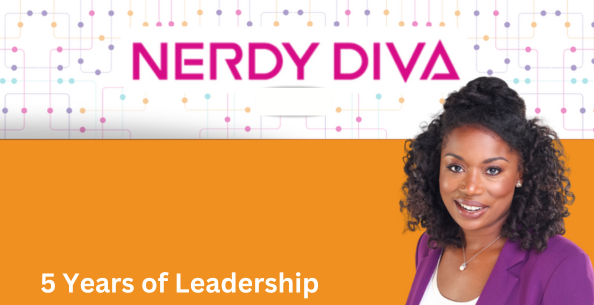Over the past five years, Shanae Chapman, the visionary founder and CEO of Nerdy Diva has navigated the dynamic landscape of technology and design, leading Nerdy Diva with a commitment to inclusivity, innovation, and resilience. MTLC recently sat down with Chapman to hear more about her leadership philosophy and her approach to guiding her team through challenges and opportunities. Read on for more in her own words.
Leadership Style & Philosophy
Your leadership journey at Nerdy Diva has been quite successful over the past five years. Can you share insights into your leadership style and philosophy?
Shanae Chapman:
Thinking back on the early years of my career, I realize the leaders who really left a mark on me were the ones who didn’t just give orders, but actually guided me through tough decisions. They didn’t just delegate tasks; they gave me opportunities to lead. And when I hit roadblocks, they didn’t just leave me stranded; they brainstormed with me to find solutions and cleared the path to my success.
Now, as a leader myself, I try to embody those same qualities. I lead by example, showing my team what it means to tackle challenges head-on. I don’t believe in one-size-fits-all leadership. Instead, I adapt to each situation, practicing both situational leadership and participatory leadership. That means I empower my team members to speak up, collaborate, embrace inclusivity, and think outside the box. I want them to feel comfortable giving feedback, taking risks, and learning from their mistakes along the way. It’s all about fostering an environment where everyone can thrive and grow.
How do you approach guiding your team, particularly in the dynamic fields of data-driven design and AI tools?
Shanae Chapman:
When it comes to guiding our team through using data-driven design tools and AI, I’m all about encouraging experimentation. I want them to feel empowered to try out new options in their design, research, and marketing processes.
But let’s not forget, AI comes with its own set of risks. That’s why I make sure to emphasize the need for critical analysis and additional research. We’ve got to be mindful of biases, inaccuracies, and potential security concerns. It’s about striking the right balance between innovation and caution as we navigate these powerful tools.
Key Elements of a Good Leader
As a leader in the tech and design industry, what, in your opinion, are the key attributes that make someone a good leader? How do these attributes contribute to fostering innovation and growth within a company?
Shanae Chapman:
Maya Analgelou’s quote rings true for me, ‘People may not remember what you say, but they will remember how you make them feel.’ I’m all about creating an environment where everyone’s not just surviving, but thriving. Being comfortable with the uncomfortable, pushing boundaries, dreaming up new tech, and coming up with design solutions that shake things up and make a positive impact. It’s a vibe where growth and innovation can flourish organically.
Navigating Economic Challenges
The business world often faces economic downturns and challenges. How did Nerdy Diva navigate and adapt during tough economic times? What strategies and leadership decisions were crucial to ensuring the company’s resilience and success?
Shanae Chapman:
Over the past few years, especially with all the ups and downs in the economy, I’ve had to figure out this delicate dance between sticking to plans, growing smart, and knowing when it’s time to switch gears or even call it quits. Using data as a guiding force in decision-making has been key. What customers needed six months ago might not be what they need now. So, I’m all about staying ahead of the curve, and having a pulse on what customers will need next. I’ve also been big on building strong relationships, sharing knowledge, and getting creative with remote work setups. It’s been a wild ride, but it’s important to be flexible in order to make it work.
Impact of Board Ready Bootcamp
Having attended the board ready bootcamp program, how has that experience influenced or shaped your perspective on leadership, especially in the context of potentially elevating to the boardroom? Were there specific takeaways that impacted your approach as a CEO?
Shanae Chapman:
It was eye-opening. I got a sneak peek into how successful boards really operate, learned some invaluable lessons from experts, and got some solid tips on how to prep for future board opportunities. You know, they say you don’t know what you don’t know, and it’s true. I soaked up so much knowledge from the expert instructors and the real-life case studies they shared. Crafting my board ready bio was a confidence boost and helped me share about my accomplishments in an authentic way, which has been helpful for sharing my expertise with potential clients for speaking engagements, training workshops, and consulting projects. The MassTLC team also made space for real dialogue. We had some tough conversations about the barriers still standing in the way of diversity and inclusion on boards. As a Black woman looking to break into the tech board scene, I’m really hoping this program sparks some meaningful change and opens up more doors for folks like me who’ve been overlooked for far too long.
Balancing Technology and Human Elements
In a field heavily influenced by technology like AI tools, how do you balance the integration of advanced tech with maintaining a human-centric approach? What role do you see emotional intelligence playing in effective leadership within the tech and design sectors?
Shanae Chapman:
Balancing integration with tools like AI alongside practicing a human-centric approach in tech and design requires a focus on enhancing rather than replacing human interactions. We can achieve this by remembering to focus on human empathy and emotional intelligence. Code has rules, but people have needs. It’s important to really understand your customers for the customer experience and what your staff needs for their employee experience. Embedding diverse perspectives in the design process through diverse research panels, and representation in design solutions is necessary in order to build systems that work for everyone. I would love to see an inclusive design check as part of the process before releasing new solutions. It’s important to ask questions like “Is this harmful?” “Is this accessible?” “Does this computer vision tool accurately identify people with dark skin?” In this approach there is both critical analysis and embracing new technology enhances rather than detracting from the human experience.
Note:
Join Shanae in an upcoming LinkedIn Live Event:
Negotiation Skills for Workplace Success



